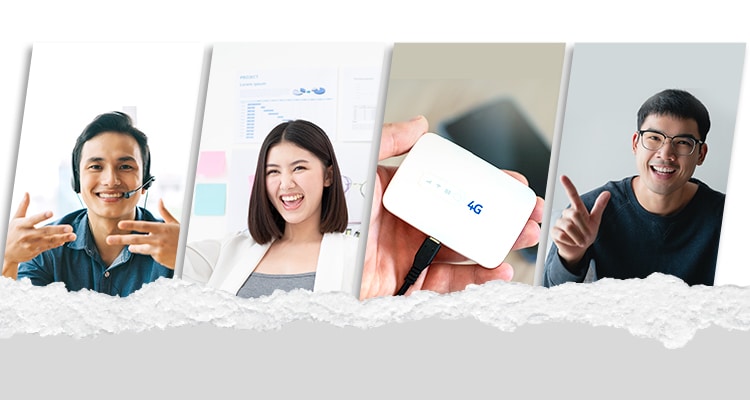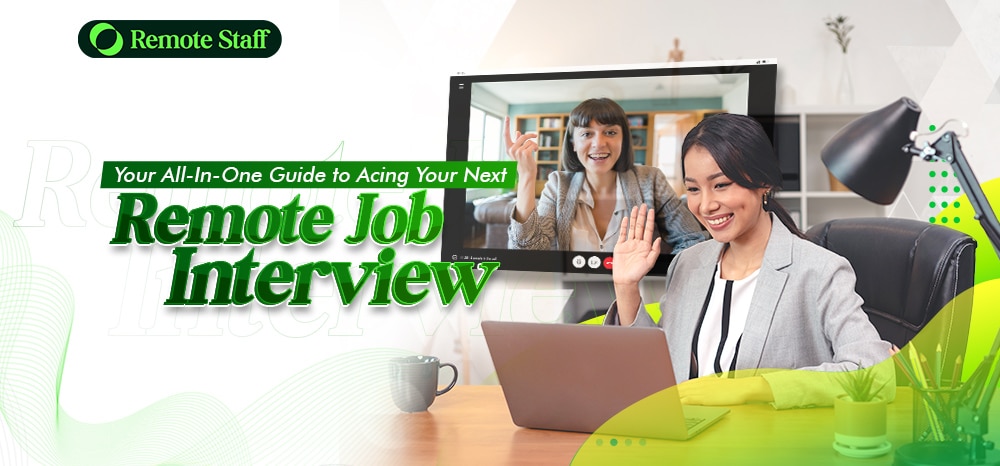One significant result of the growing popularity of remote work is the normalization of remote job interviews.
Unlike its traditional counterpart, you don’t need to head to your potential employer’s office to meet them. Instead, you just need your computer/laptop’s camera, a stable internet connection, and access to your interviewer’s chosen communication app to get started.
To remain ahead of your competition and land a work from home job, you must master the ins and outs of a remote interview. But how do you do so?
Don’t worry. Here’s a guide on how to prepare for your virtual interview, how to answer your interviewer’s questions, and what to do afterward.

1. Pre-Interview Preparations
If you’ve been on a face-to-face interview, the preparation tips you’ve used prior can still apply here.
For first-time applicants, however, here’s some pre-interview advice you should remember:
Understanding the Company
As the saying goes: “knowing is half the battle.” Before you even consider applying for a company, you should do background research on them first.
What kind of product/s or service/s do they offer? What are their core values? What is their recruitment process like? What do previous employees say about the company’s culture?
You can find answers to these questions on the company’s social media accounts and website and by checking their reviews on Google.
Doing this helps you learn more about the company and determine whether your values align with theirs.
Additionally, your interviewer may ask you some questions regarding the company, so doing your research beforehand will help you stand out.
Technical Mastery
Before your online job interview, download and know your way around common virtual platforms like Zoom, Skype, and Google Meet. This helps reduce technical glitches and enables smooth communication between you and your interviewer.
Aside from these, don’t forget to check your computer/laptop’s camera and microphone in advance to make sure they’re working.
You should also consider getting a backup pocket Wi-Fi in case of power or internet outages. This lets you push through with the interview despite these interruptions and shows your interviewer your proactiveness and professionalism.
Setting the Stage
When selecting a place to set up for your interview, choose a secluded part of your house where your family can’t easily interrupt you.
In addition, this area must also be well-lit, devoid of clutter, and have a neutral background.
Speaking of your family, inform them when your remote interview will be in advance so they won’t accidentally distract or interrupt you.
Dressing for Success
Believe it or not, there is still a dress code for remote job interviews. However, unlike a face-to-face interview, you don’t need to wear formal business attire.
Unless the company says otherwise, you can opt for business casual attire. Avoid bright and distracting colors though, wear neutral ones instead.
Although it’s very tempting to wear formal clothes from the waist up only, don’t. Not only will it be a source of embarrassment if you need to stand up, but wearing your full attire will help you focus and be more confident in facing your interviewer.
Anticipating Questions and Preparing Answers
A crucial part of preparing for your online interview is familiarizing and practicing your response to common questions such as: “Tell me about yourself?,” “What are your strengths and weaknesses?,” and “What are some of your accomplishments?”
The best way to do so is by asking a friend or family member to help you conduct a mock interview. This can help boost your confidence and enable you to reflect on past experiences to improve your answers.
Include examples that highlight your remote work skills, adaptability, and motivation, as these are traits remote employers look for the most in their employees. You can even put your answers on paper to help you remember them better.
Preparing Your Own Questions
Interviews are a way for your interviewer to gauge whether you’re a good fit for them -and for you to see whether their values align with yours.
The best way to do this is by crafting your own questions regarding the company culture and vision, their expectations of you, and how they communicate online.
Don’t forget to ask about the starting pay for the position you’re applying for, such as for a data entry specialist, for instance.
Contrary to what some may think, asking questions isn’t a turn-off for interviewers. It tells them you’re genuinely interested in the job and want to better understand the company.

2. Nailing the Interview
You’ve double-checked your setup and clicked on the interview link, and now you’re just waiting for your interviewer.
Here are some last-minute tips to help you make a great first impression:
Presentation and Communication
Just like in a face-to-face interview, ensure you maintain eye contact and smile at your interviewer. Keep your camera level with your face so your interviewer can easily see you.
Doing these helps you display confidence and openness, allowing you to better establish a connection with your interviewer.
On the other hand, avoid slouching and crossing your arms when talking to your interviewer. The former can make you come off as disinterested – while the latter makes you look defensive and closed-off.
Additionally, remember to listen closely to your interviewer to avoid asking them to repeat it. Always speak calmly and at a decent pace so they’ll understand what you’re saying.
Showcasing the Right Skills
Inevitably, your interviewer could ask you to discuss your weaknesses. When this happens, remain calm and remember the answers you’ve practiced before.
Remember to be honest about your weaknesses. That said, don’t forget to emphasize your achievements and experience too.
Staying Adaptable
Emergencies and technical difficulties can happen during an interview.
When this happens, it creates an opportunity for you to display how adaptable and creative you are.
As mentioned before, a backup pocket Wi-Fi allows you to carry on with your virtual interview despite power or internet interruptions. Also, if your mic or camera malfunctions, ensure you have a backup or can troubleshoot the issue.
Engaging With the Interviewer
Building a rapport with your interviewer isn’t easy, but doing so helps increase your chances of getting hired.
When providing examples of your skills and experience, do so in a conversational manner. That way, you can better connect with your interviewer and thus stand out better among the pool of applicants.
When they ask you if you have any questions, use this opportunity to ask the ones you’ve come up with before. Doing this shows how prepared and eager you are for the job.

3. Post-interview Etiquette
With that, you’re done! Congratulations, you’ve finished your interview.
However, now comes the hard part: the waiting.
For those who don’t know what to do next, here are some tips for you to follow:
Professional Online Presence
While waiting for their reply, you should still submit your resume to other companies, build your personal brand, and grow your network.
The best way to do so is by leveraging the power of online platforms like LinkedIn, Instagram, and YouTube.
These platforms not only allow you to expand your network but also help you showcase your skills to a broader audience. They also allow you to remain updated about any new opportunities related to your field.
To help you build your personal brand on these platforms, determine your target audience and niche first. Additionally, you must be consistent with your brand messaging and ensure they align with your core values.
Following Up
After finishing your interview, don’t forget to send a thank-you email to show them your gratitude for the opportunity. This should include your interview notes and restate your interest in the role.
Although it is tempting to regularly follow up on your application, don’t. Constantly asking your potential employer for updates will make you seem pushy and desperate.
Instead, wait a week or two before sending a follow-up email to the company’s HR or the person who interviewed you. State your continued interest in the position and inquire about your application’s status.
Give them a week to respond, as they may also be busy processing other applicants.
Reflect and Prepare for What’s Next
While waiting for your interviewer’s reply, reflect on how you performed during the interview.
What are some of the things you did right? What do you need to improve upon?
You can also use this time to prepare for the next steps of the hiring process if you get the job. These may include background checks, skill assessments, and a pre-hire orientation.

Overcoming Common Remote Interview Challenges
Some of the most common remote interview challenges include:
- Technical difficulties (mic or camera not working, sudden power and internet outages, etc.),
- Distractions at home, and
- Understanding non-verbal cues in a virtual environment.
Here are some tips to overcome these challenges:
- Get yourself a pocket Wi-Fi and regularly double-check your equipment before the interview,
- Select a more secluded part of your house for the interview and notify your loved ones when it will be so they won’t interrupt you during this period, and
- Dress appropriately, maintain eye contact with your interviewer, and practice active listening so you won’t miss anything valuable during your conversation.
Going through a job interview, whether face-to-face or virtual, is always nerve-wracking.
However, by following the tips mentioned above, you’ll have an easier time preparing, impressing your interviewer, and increasing your chances of landing an online job.
If you’re looking for online job opportunities but don’t know where to start looking, head to Remote Staff. Our jobs list contains a wide range of jobs, from data entry to online design jobs, so you’ll never run out of options.
Good luck!

